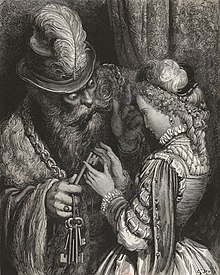Bluebeard

"Bluebeard" (French: Barbe-bleue) is a fairy tale by Charles Perrault. It first appeared in a handwritten and illustrated manuscript in 1695 titled Contes de ma mère l'oye (English: Tales of Mother Goose). The deluxe volume was intended for Mademoiselle, the 19-year-old niece of Louis XIV. It included four other tales by Perrault.[1] "Bluebeard" was first published anonymously in January 1697 in Paris by Claude Barbin in Histoires ou contes du temps passé (English: Stories or Tales of Past Times), a collection of eight fairy tales by Perrault.[2][3] The tale is about a cruel man who murders his wives so that he will inherit their wealth. He puts their corpses in a secret room opened only by a magic key.
Jacque Barchilon believes the tale is original with Perrault because there are no close antecedants. The taboo of the forbidden room is found in eastern literature, and Barchilon writes that the tale has an "Oriental character". He points out that the French associated beards with Turkish fashions, and early illustrations depict Bluebeard wearing a turban-like headdress.[4]
Medieval murderer of children Gilles de Rais may have been the inspiration for the character of Bluebeard. De Rais was a Marshal of France and Joan of Arc's military companion. His victims (mostly young boys) were said to number 140. The Breton king Comorre the Cursed (c.500 AD) is another candidate.[5] Tales similar to "Bluebeard" include "The Fitcher's Bird" by the Brothers Grimm and the English tale "Mr. Fox".[6]
Story[change | change source]
A rich man has a blue beard which frightens young women. He has been married several times but no one knows what has happened to his wives. He woos two young sisters in the neighborhood but neither are inclined to consider marriage. He treats them to a lavish time in his country house. The younger sister decides to marry him. Shortly after the wedding (and before he travels to a far land on business), Bluebeard gives his wife the keys to his house. One key opens a door to a distant room. He forbids her to enter this room. He leaves and his wife opens the door to the forbidden room. Here she finds Bluebeard's former wives, all dead and lying on a floor covered with blood. She drops the key. It is magic and becomes stained with blood that cannot be washed away. Bluebeard returns. He discovers the blood-stained key and knows his wife has disobeyed his order. He tells her she will take her place among the dead. He grants her a few minutes to pray. She calls her sister Anne and asks her to go to the top of the tower to see if her brothers are on the road. After several tense moments, Anne reports seeing the men approaching. Bluebeard raises a cutlass to decapitate his wife. Her brothers burst into the room. They kill Bluebeard. Their sister is safe.
References[change | change source]
- Barchilon, Jacques and Henry Pettit. 1960. The Authentic Mother Goose Fairy Tales and Nursery Rhymes. Denver: Alan Swallow.
- Betts, Christopher. 2009. The Complete Fairy Tales. Oxford UP. ISBN 978-0-19-923683-1.
- Opie, Iona and Peter. 1974. The Classic Fairy Tales. Oxford UP. pp. 103–5.
